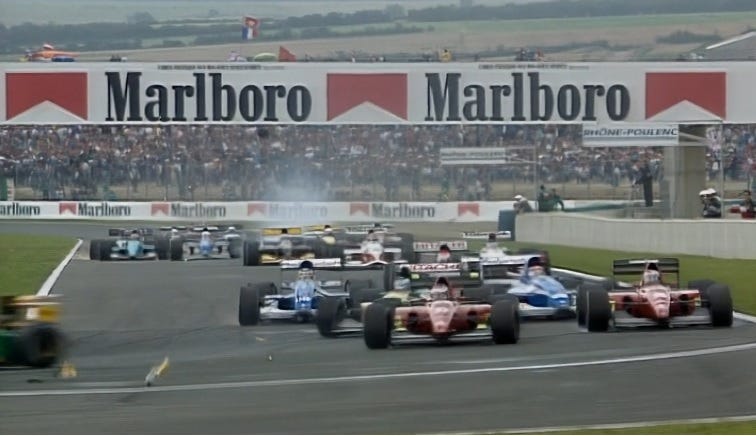Formula 1 vs. French Anti-Tobacco Legislation
How one verdict of the court in Quimper almost cancelled the 1993 French Grand Prix.
Williams' Damon Hill took his maiden pole position, upsetting his much more accomplished teammate, Alain Prost, on the Frenchman's home turf. Prost exacted sweet revenge by winning the race, finishing just 0.342 seconds ahead of Hill. This marked the first Williams 1-2 finish of the season. There is not much more to say about the 1993 French Grand Prix, as the race itself does not rank among the pantheon of Formula 1's greatest events.
Its charm lies in the surrounding sociopolitical context. The event almost didn’t occur at all, thanks to an activist organization that had leveraged French law to combat tobacco advertising.
The Battleground
In 1976, tobacco advertising was banned on television in France; however, this prohibition did not extend to sporting events. Further restrictions were enacted at the beginning of 1991, resulting in a complete ban on the promotion of cigarettes and other tobacco products. In March 1992, the French government expanded the law to include sporting events.
Enter the Comité National Contre le Tabagisme (CNCT), an organization dedicated to protecting individuals from the harmful effects of smoking and the practices of the tobacco industry.
In July 1992, the CNCT submitted an application to a court in Quimper, seeking to ban tobacco advertising on banners and other static objects during the upcoming French Grand Prix. The court approved the request and subsequently issued a fine of ₣10,000 (₣ – French franc) for every instance of such advertising.
In response, TF1, the broadcaster of Formula 1 in France, threatened to boycott the event, which would have left French fans without the opportunity to watch the race. Fortunately, an agreement was reached, and the broadcast proceeded as scheduled.
In the screenshot below, you can see how effectively the ban was enforced.
The Court Strikes Back
In November of the same year, the court in Quimper imposed fines of ₣30 million on Williams and ₣5 million on their engine supplier, Renault, for advertising Camel during the final two races of 1992 in Japan and Australia. To ensure the fines were paid, the court ordered the seizure of the team’s equipment if the fines remained unpaid.
As far as I know, French law prohibits advertising tobacco at sporting events in foreign countries as well. I believe that was the basis for the fines.
So, Williams, the 1992 World Constructors' and Drivers' Champions, essentially had to avoid France; otherwise, their cars, computers, tools, and other assets would have been seized upon arrival in the country.
Enter Max Mosley and Jean-Marie Balestre
The sport responded at the beginning of December. Max Mosley, the President of FISA (Formula 1’s governing body until 1993), decided to cancel the 1993 race at Magny-Cours, citing “the country’s stringent new laws against tobacco advertising” as the reason.
Mosley’s predecessor at the helm of FISA, Jean-Marie Balestre, who was the President of the FIA and the French Federation of Automobile Sport (FFSA) at the time, was understandably upset that his homeland had lost a race. Mosley advised him to find a way out of the cul-de-sac, if he wanted to save the French Grand Prix.
Balestre sought assistance from the Prime Minister of France, and a solution was found relatively quickly. At the end of February 1993, both Mosley and Balestre announced that Magny-Cours would host the French Grand Prix in July.
It did. Williams neither paid nor had the team's equipment seized. Additionally, there was no tobacco advertising on the banners or the cars.





